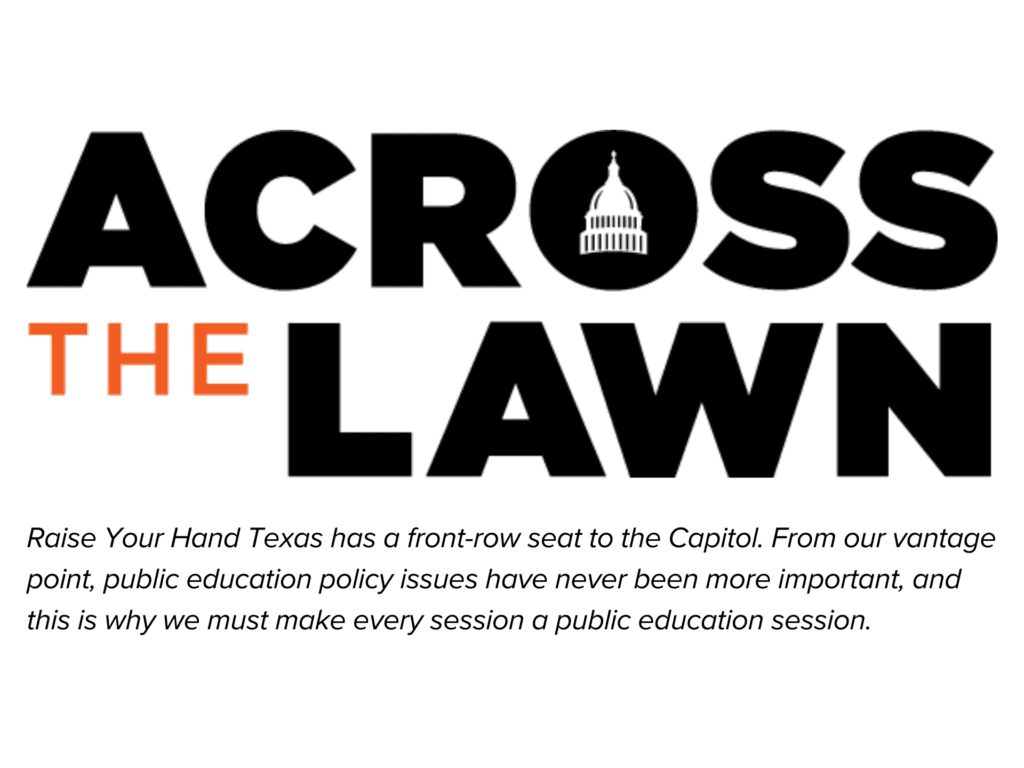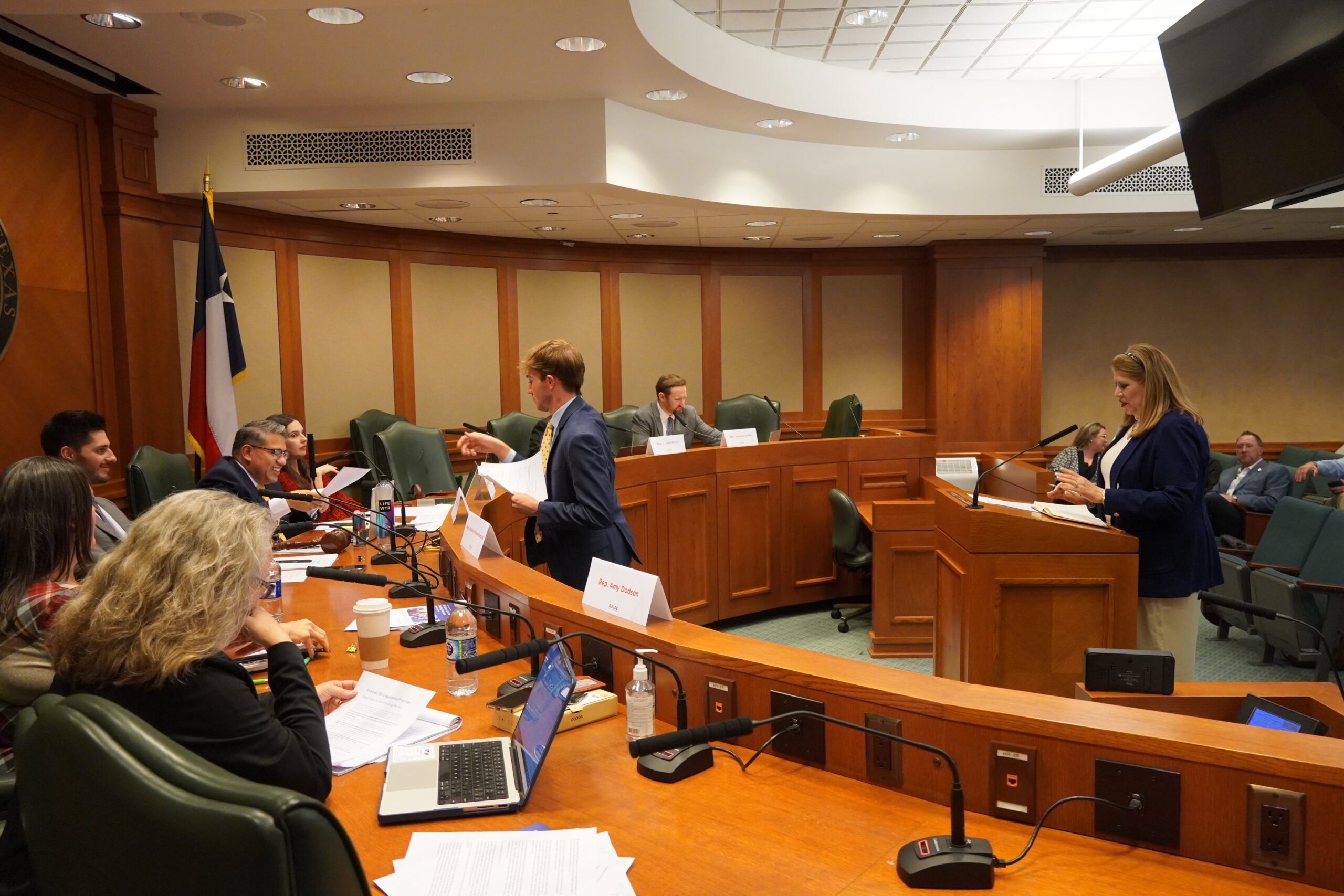
categories
Across the Lawn – February 6, 2025

February 06, 2025

One Thing to Do: Listen to Experts Discuss the Biggest Public Education Issues in the 89th Session
Listen to the latest Intersect Ed podcast. Last week, Intersect Ed host Morgan Smith was joined by Jaden Edison, public education reporter at The Texas Tribune, Scott Braddock, editor at Quorum Report.com, Edward McKinley, Austin Bureau reporter for the Houston Chronicle and the San Antonio Express-News, and Bob Popinski, senior director of policy at Raise Your Hand Texas, to discuss the major public education issues of the 89th Legislative Session.
Three Things to Know:
1. Texas Senate Passes SB 2 – Voucher Bill
The Texas Senate passed Senate Bill 2 (SB 2) with a vote of 19-12 on Wednesday night after almost eight hours of debate. There were nearly 40 amendments offered, with 20 amendments adopted, but in the end there were no major changes to the overall framework of the Education Savings Account program.
There were several amendments of note that failed to be adopted, including an amendment that would have funded a hold harmless for public schools that lost enrollment due to the program, as well as amendments that would have required similar teacher certification standards, school safety requirements, financial disclosure, and curriculum transparency.
- SB 2 by Sen. Creighton will now move to the Texas House for consideration. SB 2 allows for the following:
Every Texas student to apply for ESA, whether in public school, private school, or homeschool. - If the applications do not exceed the program’s appropriation capacity then all students are accepted. As of now, the initial Senate budget limits appropriations to $1 billion in 2027. The fiscal analysis has the program growing to $4.6 billion by 2030 if there is no appropriation cap in place.
- If applications exceed the capacity, then 80% of the positions will be filled via lottery by students who previously attended public school and are either from low-income households* or who have a disability.
- Each participating student will receive at least $2,000 ($2,500 if the student has a disability), or if a family elects to enroll their student in a private school, the student will receive $10,000 ($11,500 if the student has a disability).
Note: *Low income is defined as 500% of federal poverty guidelines or $160,750 household income for a family of four.
2. Governor Abbott Declares School Choice and Teacher Pay Emergency Items
Governor Abbott outlined seven emergency items during his State of the State last Sunday night, including:
- Property tax relief
- Water infrastructure
- Teacher pay
- Expanding career training
- School choice
- Bail reform
- Creating the Texas Cyber Command
What is an emergency item?
According to the Texas Constitution, the House and Senate can’t pass legislation during the first 60 days of a regular session. There are only two exceptions: When four-fifths of either chamber votes to suspend that rule or if the governor declares the matter an emergency. This session’s 60-day is March 14, 2025.
Governor Abbott also posted detailed recommendations for each emergency item, including teacher pay, expanding career training, school choice, and property tax relief. The recommendations include:
Teacher Pay:
- Increase teacher salaries through a direct appropriation in teacher pay and other compensation strategies
- Invest $750 million in 2026-27 to expand the Teacher Incentive Allotment, bringing more teachers into the merit pay program sooner and increasing merit pay amounts overall
- Waive fees for certification in high-need areas like special education and bilingual education
- Help mitigate costs for districts that hire retired teachers
- Invest in high-quality teacher preparation pathways, including Teacher Residencies, Apprenticeships, and Grow Your Own Programs
- Increase the Mentor Program Allotment and develop a statewide mentor teacher training
- Fund a statewide marketing campaign to recruit more teachers to the profession through high-quality pathways
- Collect data regarding teacher retention and recruitment, including the classifications, grade levels, subject areas, duration, and other relevant data relating to vacancies in teaching positions, and create a job board to address vacancies
Expanding Career Training:
- Expand high-demand career training programs by increasing funding for the Jobs and Education for Texans grant program, Pathways in Technology Early College high schools, dual credit, and other career education allotments
- Increase funding for the Rural Pathways Excellence Partnership program to support rural districts in expanding career training options for students and addressing regional workforce needs
- Provide career and technical education funding for students enrolled in Junior Reserve Officers’ Training Corps (JROTC) programs
- Improve career advising and provide funding for career readiness assessments to ensure students are recommended courses best aligned with their career goals
- Invest in strategies to ensure students enter high school proficient in math and prepared to excel in career-aligned courses
School Choice:
- Establish an education savings account (ESA) program with universal eligibility for all Texas schoolchildren and appropriate $1 billion for the program to parents to choose the best education for their child
- Ensure participation is entirely voluntary for families and schools
- Increase public school choice opportunities by increasing funding for open-enrollment charter school facilities, expanding virtual education options, and improving access to inter- and intra-district transfers
Property Tax Relief:
- Require all local bond issues and tax rate elections be on the November ballot and approved by a two-thirds supermajority of voters
- Use at least $10 billion of the state’s budget surplus for property tax relief
- Speed-up tax rate compression to lower school district M&O tax rates, providing relief for all property taxpayers
- Eliminate local taxing authorities’ loopholes by requiring two-thirds voter approval for all tax increases
- Increase the business personal property tax exemption to $100,000 to support small businesses
3. President Trump Issues Executive Order on Redirecting Federal Funds for Private School Vouchers
Last week, President Trump signed an executive order that will eventually direct federal grants and discretionary funding away from public schools, redirecting the funds towards private school vouchers.
The order directs the U.S. Department of Education and the Department of Health and Human Services (HHS) to repurpose funds from public schools, childcare providers, and nonprofit organizations for the benefit of private schooling and homeschooling initiatives. The exact mechanism for how these funds will be redirected—without Congressional approval—remains uncertain.
The order gives the education secretary 60 days to issue guidance on how federal funds will be used for educational choice, with the Department of Health and Human Services tasked with exploring how childcare block grants might be used to support educational alternatives within 90 days.
President Trump also signed a separate executive order aimed at defunding schools that teach what he refers to as “discriminatory equity ideology” or “gender ideology.”



